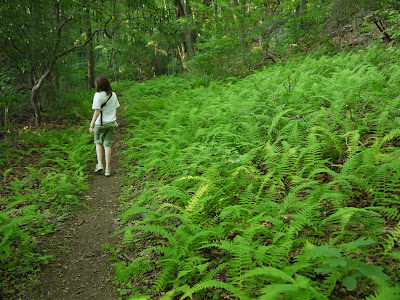 The above newly installed deer exclosure was created at Bluff Point State Park in Groton, Connecticut, in 1990, which had an very high deer population at the time. As you can see, the ground is covered with grass only, so it actually looks like a lawn. The DEP documented deer dieing of starvation during the winter, and began to cull the herd that year.
The above newly installed deer exclosure was created at Bluff Point State Park in Groton, Connecticut, in 1990, which had an very high deer population at the time. As you can see, the ground is covered with grass only, so it actually looks like a lawn. The DEP documented deer dieing of starvation during the winter, and began to cull the herd that year. Here's the same location in 1995. I saw this exclosure in 1993, and the image has stayed with me ever since. Although there was some hunting starting in 1990, it wasn't until 1996 that the population was reduced drastically.
Here's the same location in 1995. I saw this exclosure in 1993, and the image has stayed with me ever since. Although there was some hunting starting in 1990, it wasn't until 1996 that the population was reduced drastically. And here's the same location in 2001, after the DEP drastically culled the deer population. The DEP deer hunt was (and probably still is) very controversial: Here's a NYTimes article from 1990 and another in 2001.
And here's the same location in 2001, after the DEP drastically culled the deer population. The DEP deer hunt was (and probably still is) very controversial: Here's a NYTimes article from 1990 and another in 2001."Mr. May said Bluff Point's oak forest had almost no sprouts or undergrowth of any kind in the mid-1980's and that around that time the agency's biologists were finding starving deer in the spring. They examined the bones of some of the dead deer and found their marrow was liquid instead of solid, as it should be, a sign the animals were severely malnourished, he said.
''It was not a situation that anybody could consider to be humane or natural,'' Mr. May said.
Since the hunts started, the average weights of the deer removed from Bluff Point have gone up, and the vegetation is starting to grow back, said Edward Parker, chief of the agency's Bureau of Natural Resources."
Note: The photos above have been widely circulated and published. I believe they originated from the DEP, but I'm not sure.














